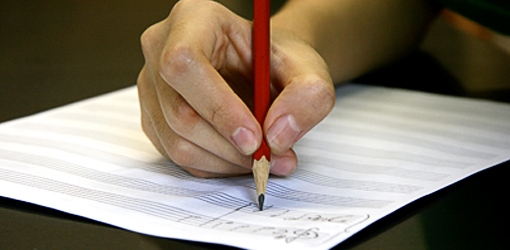Ear training, also known as aural training, is an essential part of music education. Unfortunately it is often ignored by students who focus on developing technical instrument skills or simply playing music. This attitude is especially common among amateur musicians, but even those studying music in a more formal setting often treat ear training as a chore and a distraction. In this post I hope to explain why ear training is essential for becoming a well-rounded musician. Let’s begin by talking about what ear training is, and what it isn’t.
You may have heard about people who have a “good ear,” but what does that really mean? Imagine an average person eating a delicious meal at a restaurant or admiring a beautiful painting at a gallery. In all likelihood that person will consider the meal delicious, the painting beautiful, and go on with his day. Now, imagine a trained chef tasting the meal and a talented painter admiring the painting. It is very likely that both of them will be able to appreciate their experiences on a much deeper level. A good chef will probably be able to guess the ingredients of the meal and why they go well together. Similarly, a good painter will understand the use of color, tone, style, and what makes the painting work. You could say that the chef has a good palate, and the painter has a good eye. Having a good ear is no different. For those who have a good ear, a musical piece is more than just a collection of pleasant sounds – it is a collection of building blocks, like rhythms, notes, intervals, and chords. These all come together to make the music what it is.
What is ear training…
Not surprisingly, ear training is all about developing your ears and making them “good”. By developing the ear, we can dissect music, take a look inside, and see what makes it tick. Not only does this allow us to understand and appreciate music at a whole new level, but it allows us to play learn music “by ear” and improve our repertoire.
All music consists of rhythms and pitches. Developing a sense of rhythm makes it possible to feel the beat in music and how it is subdivided. Developing a sense of pitch makes it possible to see what is happening with the melody and harmony. There are many skills that fall under the ear training umbrella. Let’s take a look at rhythm and pitch recognition.
Rhythm imitation
Rhythm imitation exercises teach you to feel the underlining musical beat and rhythm patterns in the music you hear. This will allow you to accurately clap along with the song and reproduce the rhythm on your instrument.
Pitch recognition
Interval recognition exercises teach you to feel the distances between notes, which make up melodies. This will help you memorize and play the melodies that you hear.
Chord recognition exercises teach you to recognize the underlining harmony of the song and the relationship between the harmony and the melody.
What ear training is not…
While we’re talking about what ear training is, perhaps it is also useful to mention what it isn’t. First of all, ear training is not a substitute for learning music theory. While developing a good ear is very important, it is only a part of the picture. Developing a good ear will allow you to hear what is happening in the music, but not why it works. Good knowledge of music theory will fill in the gaps and allow you to understand what you hear at a much deeper level.
Ear training is also not about developing perfect pitch – the ability to instantly recognize a note upon hearing it. Perfect pitch is a great ability to have, but it is widely considered unteachable. You are either born with it or you are not. Fortunately, having a perfect pitch is hardly a requirement to be a good musician. Relative pitch – being able to recognize the distance between notes – is by far the the more important skill to have for a musician, and it can be developed using interval and chord recognition exercises.
Conclusion
I hope this post gave you a good idea of what ear training is and encouraged you to learn more. Ear training has become increasingly popular in the recent years, with many books, audio CDs, and software dedicated to its study. In fact, our own ear training software, Ear Teacher, will be launching soon. Stay tuned!
Ready to start learning?
Join 13,500+ happy users today!
We offer a 14-day money back guarantee, so purchasing is risk-free!

